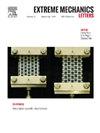生长诱导的Donnan排斥影响高电荷动态聚合水凝胶的溶胀动力学
IF 4.5
3区 工程技术
Q2 MATERIALS SCIENCE, MULTIDISCIPLINARY
引用次数: 0
摘要
由DNA序列交联的聚合物凝胶可以利用DNA链位移反应通过动态聚合促进膨胀。膨胀的程度和膨胀的速度必须直接可调,以实现可编程软物质的承诺。虽然链位移反应的动力学提供的插入速率高达104/摩尔/秒,但DNA水凝胶膨胀可能需要30小时以上才能完成。利用我们最近开发的反应性电化学力学理论(Zimmerman et al., 2024)对这些凝胶的反应诱导膨胀进行计算建模表明,它们异常缓慢的膨胀部分是由于添加电荷和添加流体体积之间的尺度不匹配,导致固定电荷密度瞬间大幅增加。由于带负电荷的DNA的结合,凝胶的固定电荷密度显著增加,通过Donnan电荷排除现象,极大地限制了移动发夹的浓度,这种效应通常用于使用聚合物膜的纳滤应用。当添加交联给水凝胶提供的平均额外膨胀超过临界值时,就可以克服结垢问题,因此膨胀速度超过电荷积累速度,导致固定电荷密度下降,并显著加速膨胀过程。本研究表明,Donnan不排除可以解释DNA水凝胶膨胀的动力学,并研究了通过改变盐浓度或增加或减少每个DNA序列的碱基对数量来调节反应速度的方法。本文章由计算机程序翻译,如有差异,请以英文原文为准。

Growth-induced Donnan exclusion influences swelling kinetics in highly charged dynamic polymerization hydrogels
Polymeric gels crosslinked by DNA sequences can exploit DNA strand-displacement reactions to promote swelling through dynamic polymerization. The degree of swelling and the rate of swelling must be directly tunable to achieve the promise of programmable soft matter. Though the kinetics of the strand-displacement reaction provide insertion rates up to /Molar/second as measured in bulk solution, DNA hydrogel swelling can take upwards of 30 h to complete. Computational modeling of the reaction-induced swelling of these gels with our recently-developed reactive electrochemomechanical theory (Zimmerman et al., 2024) suggests that their extraordinarily slow swelling is partly due to a scaling mismatch between the addition of charge and the addition of fluid volume, leading to a large transient increase in the fixed charge density. The significant increase in the gel’s fixed charge density, due to the binding of negatively charged DNA, sharply restricts the concentration of mobile hairpins through the phenomenon of Donnan charge exclusion, an effect commonly exploited in nanofiltration applications using polymeric membranes. The scaling problem is overcome when the mean additional swelling provided to the hydrogel by addition of a crosslink is above a critical value, thus the swelling outpaces the charge accumulation, leading the fixed charge density to drop and significantly accelerating the swelling process. This study shows that Donnan exclusion can explain the kinetics of DNA hydrogel swelling, and studies ways to modulate the reaction speed by either modifying the salt concentration or increasing or decreasing the number of base pairs in each DNA sequence.
求助全文
通过发布文献求助,成功后即可免费获取论文全文。
去求助
来源期刊

Extreme Mechanics Letters
Engineering-Mechanics of Materials
CiteScore
9.20
自引率
4.30%
发文量
179
审稿时长
45 days
期刊介绍:
Extreme Mechanics Letters (EML) enables rapid communication of research that highlights the role of mechanics in multi-disciplinary areas across materials science, physics, chemistry, biology, medicine and engineering. Emphasis is on the impact, depth and originality of new concepts, methods and observations at the forefront of applied sciences.
 求助内容:
求助内容: 应助结果提醒方式:
应助结果提醒方式:


